Hay
Hay is grass, legumes, or other herbaceous plants that have been cut and dried to be stored for use as animal fodder, particularly for large grazing animals raised as livestock, such as cattle, horses, goats, and sheep. However, it is also fed to smaller domesticated animals such as rabbits and guinea pigs. Pigs may also be fed hay, but they do not digest it as efficiently as herbivores.


Hay can be used as animal fodder when or where there is not enough pasture or rangeland on which to graze an animal, when grazing is not feasible due to weather (such as during the winter), or when lush pasture by itself would be too rich for the health of the animal. It is also fed when an animal is unable to access pasture, e.g. the animal is being kept in a stable or barn.
Composition
Commonly used plants for hay include mixtures of grasses such as ryegrass (Lolium species), timothy, brome, fescue, Bermuda grass, orchard grass, and other species, depending on region. Hay may also include legumes, such as alfalfa (lucerne) and clovers (red, white and subterranean). Legumes in hay are ideally cut pre-bloom. Other pasture forbs are also sometimes a part of the mix, though these plants are not necessarily desired as certain forbs are toxic to some animals.
Oat, barley, and wheat plant materials are occasionally cut green and made into hay for animal fodder; however they are more usually used in the form of straw, a harvest byproduct where the stems and dead leaves are baled after the grain has been harvested and threshed. Straw is used mainly for animal bedding. Although straw is also used as fodder, particularly as a source of dietary fiber, it has lower nutritional value than hay.
It is the leaf and seed material in the hay that determines its quality, because they contain more of the nutrition value for the animal than the stems do.[1]:194 Farmers try to harvest hay at the point when the seed heads are not quite ripe and the leaf is at its maximum when the grass is mowed in the field. The cut material is allowed to dry so that the bulk of the moisture is removed but the leafy material is still robust enough to be picked up from the ground by machinery and processed into storage in bales, stacks or pits. Methods of haymaking thus aim to minimize the shattering and falling away of the leaves during handling.[1]:194

Hay is very sensitive to weather conditions, especially when it is harvested. In drought conditions, both seed and leaf production are stunted, making hay that has a high ratio of dry coarse stems that have very low nutritional values. If the weather is too wet, the cut hay may spoil in the field before it can be baled. Thus the biggest challenge and risk for farmers in producing hay crops is the weather, especially the weather of the particular few weeks when the plants are at the best age/maturity for hay. A lucky break in the weather often moves the haymaking tasks (such as mowing, tedding, and baling) to the top priority on the farm's to-do list. This is reflected in the idiom to make hay while the sun shines. Hay that was too wet at cutting may develop rot and mold after being baled, creating the potential for toxins to form in the feed, which could make the animals sick.
After harvest, hay also has to be stored in a manner to prevent it from getting wet. Mold and spoilage reduce nutritional value and may cause illness in animals. A symbiotic fungus in fescue may cause illness in horses and cattle.[2]
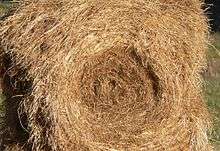
The successful harvest of maximum yields of high-quality hay is entirely dependent on the coincident occurrence of optimum crop, field, and weather conditions. When this occurs, there may be a period of intense activity on the hay farm while harvest proceeds until weather conditions become unfavourable.
Feeding hay
Hay or grass is the foundation of the diet for all grazing animals and can provide as much as 100% of the fodder required for an animal. Hay is usually fed to an animal in place of allowing the animal to graze on grasses in a pasture, particularly in the winter or during times when drought or other conditions make pasture unavailable. Animals that can eat hay vary in the types of grasses suitable for consumption, the ways they consume hay, and how they digest it. Therefore, different types of animals require hay that consists of similar plants to what they would eat while grazing, and likewise, plants that are toxic to an animal in pasture are also toxic if they are dried into hay.
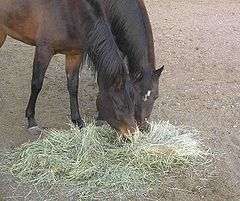
Most animals are fed hay in two daily feedings, morning and evening. However, this schedule is more for the convenience of humans, as most grazing animals on pasture naturally consume fodder in multiple feedings throughout the day. Some animals, especially those being raised for meat, may be given enough hay that they simply are able to eat all day. Other animals, especially those that are ridden or driven as working animals, are only free to eat when not working, and may be given a more limited amount of hay to prevent them from getting too fat. The proper amount of hay and the type of hay required varies somewhat between different species. Some animals are also fed concentrated feeds such as grain or vitamin supplements in addition to hay. In most cases, hay or pasture forage must make up 50% or more of the diet by weight.
One of the most significant differences in hay digestion is between ruminant animals, such as cattle and sheep; and nonruminant, hindgut fermentors, such as horses. Both types of animals can digest cellulose in grass and hay, but do so by different mechanisms. Because of the four-chambered stomach of cattle, they are often able to break down older forage and have more tolerance of mold and changes in diet. The single-chambered stomach and cecum or "hindgut" of the horse uses bacterial processes to break down cellulose that are more sensitive to changes in feeds and the presence of mold or other toxins, requiring horses to be fed hay of a more consistent type and quality.[3]
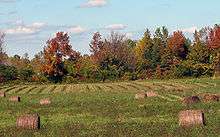
Different animals also use hay in different ways: cattle evolved to eat forages in relatively large quantities at a single feeding, and then, due to the process of rumination, take a considerable amount of time for their stomachs to digest food, often accomplished while the animal is lying down, at rest. Thus quantity of hay is important for cattle, who can effectively digest hay of low quality if fed in sufficient amounts. Sheep will eat between two and four percent of their body weight per day in dry feed, such as hay,[4] and are very efficient at obtaining the most nutrition possible from three to five pounds per day of hay or other forage.[5] They require three to four hours per day to eat enough hay to meet their nutritional requirements.[6]
Unlike ruminants, horses digest food in small portions throughout the day, and can only use approximately 2.5% of their body weight in feed in any 24-hour period. They evolved to be continuously on the move while grazing, (covering up to 50 miles (80 km) per day in the wild) and their stomach digests food quite rapidly. Thus, they extract more nutrition out of smaller quantities of feed.[7] However, when horses are fed low-quality hay, they may develop an unhealthy, obese, "hay belly" due to over-consumption of "empty" calories. If their type of feed is changed dramatically, or if they are fed moldy hay or hay containing toxic plants, they can become ill; colic is the leading cause of death in horses. Contaminated hay can also lead to respiratory problems in horses. Hay can be soaked in water, sprinkled with water or subjected to steaming to reduce dust.
Making and transporting hay

(NRCS_Photo_Gallery).jpg)
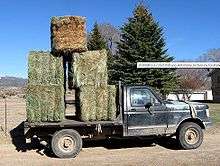

Hay production and harvest, commonly known as "making hay",[8] "haymaking", or "doing hay", involves a multiple step process: cutting, drying or "curing", raking, processing, and storing. Hayfields do not have to be reseeded each year in the way that grain crops are, but regular fertilizing is usually desirable, and overseeding a field every few years helps increase yield.
Methods and the terminology to describe the steps of making hay have varied greatly throughout history, and many regional variations still exist today. However, whether done by hand or by modern mechanized equipment, tall grass and legumes at the proper stage of maturity must be cut, then allowed to dry (preferably by the sun), then raked into long, narrow piles known as windrows. Next, the cured hay is gathered up in some form (usually by some type of baling process) and placed for storage into a haystack or into a barn or shed to protect it from moisture and rot.
During the growing season, which is spring and early summer in temperate climates, grass grows at a fast pace. It is at its greatest nutritive value when all leaves are fully developed and seed or flower heads are just a bit short of full maturity. When growth is at a maximum in the pasture or field, if judged correctly, it is cut. Grass hay cut too early will not cure as easily due to high moisture content, plus it will produce a lower yield per acre than longer, more mature grass. But hay cut too late is coarser, lower in resale value and has lost some of its nutrients. There is usually about a two-week "window" of time in which grass is at its ideal stage for harvesting hay. The time for cutting alfalfa hay is ideally done when plants reach maximum height and are producing flower buds or just beginning to bloom, cutting during or after full bloom results in lower nutritional value of the hay.
Hay can be raked into rows as it is cut, then turned periodically to dry, particularly if a modern swather is used. Or, especially with older equipment or methods, the hay is cut and allowed to lie spread out in the field until it is dry, then raked into rows for processing into bales afterwards. During the drying period, which can take several days, the process is usually sped up by turning the cut hay over with a hay rake or spreading it out with a tedder. If it rains while the hay is drying, turning the windrow can also allow it to dry faster. However, turning the hay too often or too roughly can also cause drying leaf matter to fall off, reducing the nutrients available to animals. Drying can also be sped up by mechanized processes, such as use of a hay conditioner, or by use of chemicals sprayed onto the hay to speed evaporation of moisture, though these are more expensive techniques, not in general use except in areas where there is a combination of modern technology, high prices for hay, and too much rain for hay to dry properly.[9]
Once hay is cut, dried and raked into windrows, it is usually gathered into bales or bundles, then hauled to a central location for storage. In some places, depending on geography, region, climate, and culture, hay is gathered loose and stacked without being baled first.
Hay must be fully dried when baled and kept dry in storage. If hay is baled while too moist or becomes wet while in storage, there is a significant risk of spontaneous combustion.[10] Hay stored outside must be stacked in such a way that moisture contact is minimal. Some stacks are arranged in such a manner that the hay itself "sheds" water when it falls. Other methods of stacking use the first layers or bales of hay as a cover to protect the rest. To completely keep out moisture, outside haystacks can also be covered by tarps, and many round bales are partially wrapped in plastic as part of the baling process. Hay is also stored under a roof when resources permit. It is frequently placed inside sheds, or stacked inside of a barn. On the other hand, care must also be taken that hay is never exposed to any possible source of heat or flame, as dry hay and the dust it produces are highly flammable.
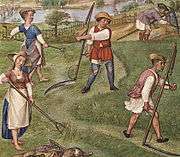
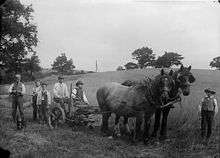
Early methods
Early farmers noticed that growing fields produced more fodder in the spring than the animals could consume, and that cutting the grass in the summer, allowing it to dry and storing it for the winter provided their domesticated animals with better quality nutrition than simply allowing them to dig through snow in the winter to find dried grass. Therefore, some fields were "shut up" for hay.
Up to the end of the 19th century, grass and legumes were not often grown together because crops were rotated. However, by the 20th century, good forage management techniques demonstrated that highly productive pastures were a mix of grasses and legumes, so compromises were made when it was time to mow. Later still, some farmers grew crops, like straight alfalfa (lucerne), for special-purpose hay such as that fed to dairy cattle.
Much hay was originally cut by scythe by teams of workers, dried in the field and gathered loose on wagons. Later, haying would be done by horse-drawn implements such as mowers. With the invention of agricultural machinery such as the tractor and the baler, most hay production became mechanized by the 1930s.
After hay was cut and had dried, the hay was raked or rowed up by raking it into a linear heap by hand or with a horse-drawn implement. Turning hay, when needed, originally was done by hand with a fork or rake. Once the dried hay was rowed up, pitch forks were used to pile it loose, originally onto a horse-drawn cart or wagon, later onto a truck or tractor-drawn trailer, for which a sweep could be used instead of pitch forks.
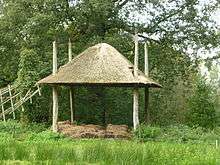

Loose hay was taken to an area designated for storage—usually a slightly raised area for drainage—and built into a hay stack. The stack was made waterproof as it was built (a skilled task) and the hay would compress under its own weight and cure by the release of heat from the residual moisture in the hay and from the compression forces. The stack was fenced from the rest of the paddock in a rick yard, and often thatched or sheeted to keep it dry. When needed, slices of hay would be cut using a hay knife and fed out to animals each day.
On some farms the loose hay was stored in a barrack, shed, or barn, normally in such a way that it would compress down and cure. Hay could be stored in a specially designed barn with little internal structure to allow more room for the hay loft. Alternatively, an upper storey of a cow-shed or stable was used, with hatches in the floor to allow hay to be thrown down into hay-racks below.
Depending on region, the term "hay rick" could refer to the machine for cutting hay, the hay stack or the wagon used to collect the hay.
Hay baling began with the invention of the first hay press in about 1850.[11] Hay was baled for easier handling and to reduce space required for storage and shipment. The first bales weighed about 300 lb. The original machines were of the vertical design similar to the one photographed by Greene Co. Historical Society. They used a horse driven screw press mechanism or a dropped weight to compress the hay. The first patent went to HL Emery for a horse powered, screw operated hay press in 1853. Other models were reported as early as 1843 built by PK Dederick's Sons of Albany, NY, or Samuel Hewitt of Switzerland County, Ohio.[12] Later horizontal machines were devised. One was the “Perpetual Press” made by PK Dederick of Albany, NY, in 1872. They could be powered by steam engines by about 1882. The continuous hay baler arrived in 1914.
Modern mechanized techniques

Modern mechanized hay production today is usually performed by a number of machines. While small operations use a tractor to pull various implements for mowing and raking, larger operations use specialized machines such as a mower or a swather, which are designed to cut the hay and arrange it into a windrow in one step. Balers are usually pulled by a tractor, with larger balers requiring more powerful tractors.
Mobile balers, machines which gather and bale hay in one process, were first developed around 1940. The first balers produced rectangular bales small enough for a person to lift, usually between 70 and 100 pounds (32 and 45 kg) each. The size and shape made it possible for people to pick bales up, stack them on a vehicle for transport to a storage area, then build a haystack by hand. However, to save labor and increase safety, loaders and stackers were also developed to mechanise the transport of small bales from the field to the haystack. Later in the 20th century, balers were developed capable of producing large bales that weigh up to 3,000 pounds (1,400 kg).[13]
Conditioning of hay has become popular. The basic idea is that it decreases drying time, particularly in humid climates or if rain interferes with haying. Usually, a salt solution is sprayed over the top of the hay (generally alfalfa) that helps to dry the hay. Conditioning can also refer to the rollers inside a swather that crimps the alfalfa to help squeeze out the moisture.
Fertilization and weed control
Modern hay production often relies on artificial fertilizer and herbicides. Traditionally, manure has been used on hayfields, but modern chemical fertilizers are used today as well. Hay that is to be certified as weed-free for use in wilderness areas must often be sprayed with chemical herbicides to keep unwanted weeds from the field, and sometimes even non-certified hayfields are sprayed to limit the production of noxious weeds. However, organic forms of fertilization and weed control are required for hay grown for consumption by animals whose meat will ultimately be certified organic. To that end, compost and field rotation can enhance soil fertility, and regular mowing of fields in the growth phase of the hay will often reduce the prevalence of undesired weeds. In recent times, some producers have experimented with human sewage sludge to grow hay. This is not a certified organic method and no warning labels are mandated by EPA.[14] One concern with hay grown on human sewage sludge is that the hay can take up heavy metals, which are then consumed by animals.[15] Molybdenum poisoning is a particular concern in ruminants such as cows and goats, and there have been animal deaths.[16][17][18] Another concern is with a herbicide known as aminopyralid, which can pass through the digestive tract in animals, making their resulting manure toxic to many plants and thus unsuitable as fertilizer for food crops.[19] Aminopyralid and related herbicides can persist in the environment for several years.
Baling
Small bales
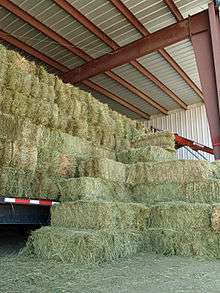
Small bales are still produced today. While balers for small bales are still manufactured, as well as loaders and stackers, there are some farms that still use equipment manufactured over 50 years ago, kept in good repair. The small bale remains part of overall ranch lore and tradition with "hay bucking" competitions still held for fun at many rodeos and county fairs.
Small square bales are stacked in a criss-crossed fashion sometimes called a "rick" or "hayrick". Rain tends to wash nutrition out of hay and can cause spoilage or mold. Hay in small square bales is particularly susceptible to this, and is therefore often stored in a hayshed or protected by tarpaulins. If this is not done, the top two layers of the stack are often lost to rot and mold, and if the stack is not arranged in a proper hayrick, moisture can seep even deeper into the stack. The rounded shape and tighter compaction of small (and large) round bales makes them less susceptible to spoilage, as the water is less likely to penetrate into the bale. The addition of net wrap, which is not used on square bales, offers even greater weather resistance.
People who keep small numbers of animals may prefer small bales that can be handled by one person without machinery. There is also a risk that hay bales may be moldy, or contain decaying carcasses of small creatures that were accidentally killed by baling equipment and swept up into the bale, which can produce toxins such as botulinum toxin. Both can be deadly to non-ruminant herbivores, such as horses, and when this occurs, the entire contaminated bale generally is thrown out, another reason some people continue to support the market for small bales.
Large bales
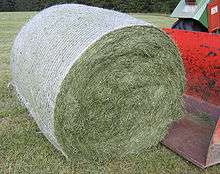
Farmers who need to make large amounts of hay are likely to choose balers which produce much larger bales, maximizing the amount of hay which is protected from the elements. Large bales come in two types, round and square. Large square bales, which can weigh up to 1,000 kilograms (2,200 lb), can be stacked and are easier to transport on trucks. Large round bales, which typically weigh 300 to 400 kilograms (660–880 lb), are more moisture-resistant, and pack the hay more densely (especially at the center). Round bales are quickly fed with the use of mechanized equipment.
The ratio of volume to surface area makes it possible for many dry-area farmers to leave large bales outside until they are consumed. Wet-area farmers and those in climates with heavy snowfall can stack round bales under a shed or tarp, but can also use a light but durable plastic wrap that partially encloses bales left outside. The wrap repels moisture, but leaves the ends of the bale exposed so that the hay itself can "breathe" and does not begin to ferment. However, when it is possible to store round bales under a shed, they last longer and less hay is lost to rot and moisture.[20]
Haylage
For animals that eat silage, a bale wrapper may be used to seal a round bale completely and trigger the fermentation process. It is a technique used as a money-saving process by producers who do not have access to a silo, and for producing silage that is transported to other locations. However, a silo is still a preferred method for making silage.[21] In very damp climates, it is a legitimate alternative to drying hay completely and when processed properly, the natural fermentation process prevents mold and rot. Round bale silage is also sometimes called "haylage", and is seen more commonly in Europe than in either the United States or Australia. However, hay stored in this fashion must remain completely sealed in plastic, as any holes or tears can stop the preservation properties of fermentation and lead to spoilage.[22]
Haystacks
Haystacks are stacks of harvested hay, stacked in many different ways depending on region of the world, climate, if baled or loose, and so on.
Hay requires protection from weather, and is optimally stored inside buildings,[23]:89 but weather protection is also provided in other ways involving outdoor storage, either in haystacks or in large tight bales (round or rectangular); these methods all depend on the surface of an outdoor mass of hay (stack or bale) taking the hit of the weather and thereby preserving the main body of hay underneath.
Traditionally, outdoor hay storage was done with haystacks of loose hay, where most of the hay was sufficiently preserved to last through the winter, and the top surface of the stack (being weathered) was consigned to become compost the next summer. The term "loose" means not pressed or baled, but it doesn't necessarily mean a light, fluffy lay of randomly oriented stems. Especially in wet climates, such as those of Britain, the degree of shedding of rainwater by the stack's outer surface is an important factor, and the stacking of loose hay was developed into a skilled-labor task that in its more advanced forms even involved thatching the top. In many stacking methods (with or without thatched tops), stems were oriented in sheaves, which were laid in oriented sequence.
With the advent of large bales since the 1960s, today hay is often stored outdoors because the outer surface of the large bale performs the weather-shedding function. The large bales can also be stacked, which allows a given degree of exposed surface area to count for a larger volume of protected interior hay. Plastic tarpaulins are sometimes used to shed the rain, with a goal of reduced hay wastage, but the cost of the tarpaulins must be weighed against the cost of the hay spoilage percentage difference; it may not be worth the cost, or the plastic's environmental footprint.
After World War II, British farmers found that the demand outstripped supply for skilled farm laborers experienced in the thatching of haystacks.[24] This no doubt contributed to the pressure for baling in large bales to increasingly replace stacking, which was happening anyway as haymaking technology (like other farm technology) continued toward extensive mechanization with one-man operation of many tasks. Today tons of hay can be cut, conditioned, dried, raked, and baled by one person, as long as the right equipment is at hand (although that equipment is expensive). These tons of hay can also be moved by one person, again with the right (expensive) equipment, as loaders with long spikes run by hydraulic circuits pick up each large bale and move it to its feeding location.
A fence may be built to enclose a haystack and prevent roaming animals from eating it,[25][26] or animals may feed directly from a field-constructed stack as part of their winter feeding.[27]
Haystacks are also sometimes called haycocks; among some users this term refers more specifically to small piles of cut-and-gathered hay awaiting stacking into larger stacks.[28] The words (haystack, haycock) are usually styled as solid compounds, but not always. Haystacks are also sometimes called stooks, shocks, or ricks.
Loose hay stacking
Loose stacks are built to prevent accumulation of moisture and promote drying, or curing. In some places, this is accomplished by constructing stacks with a conical or ridged top.[25][29] The exterior may look gray on the surface after weathering, but the inner hay retains traces of its fresh-cut aroma and maintains a faded green tint.[25] They can be covered with thatch,[29][30] or kept within a protective structure. One such structure is a moveable roof supported by four posts, historically called a Dutch roof, hay barrack, or hay cap.[30][31] Haystacks may also be built on top of a foundation laid on the ground to reduce spoilage, in some places made of wood or brush.[25] In other areas, hay is stacked loose, built around a central pole, a tree, or within an area of three or four poles to add stability to the stack.[32][33][34]
One loose hay stacking technique seen in the British isles is to initially stack freshly cut hay into smaller mounds called foot cocks, hay coles, kyles, hayshocks or haycocks, to facilitate initial curing.[25][35] These are sometimes built atop platforms or tripods formed of three poles, used to keep hay off the ground and let air into the center for better drying.[36] The shape causes dew and rain water roll down the sides, allowing the hay within to cure.[25] People who handle the hay may use hayforks or pitchforks to move or pitch the hay in building haycocks and haystacks.[25][37] Construction of tall haystacks is sometimes aided with a ramp, ranging from simple poles to a device for building large loose stacks called a beaverslide.[25][38]
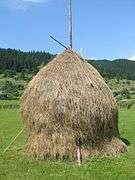 Loose stacked hay built around a central pole, supported by side poles in Romania
Loose stacked hay built around a central pole, supported by side poles in Romania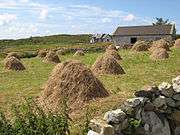 Hay cocks in a field in Ireland
Hay cocks in a field in Ireland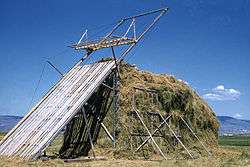 A beaverslide with a full stack of hay in Montana, USA
A beaverslide with a full stack of hay in Montana, USA
Safety issues
Farmer's lung (not to be confused with silo-filler's disease) is a hypersensitivity pneumonitis induced by the inhalation of biologic dusts coming from hay dust or mold spores or other agricultural products.[39] Exposure to hay can also trigger allergic rhinitis for people who are hypersensitive to airborne allergens.
Hay baled before it is fully dry can produce enough heat to start a fire. Haystacks produce internal heat due to bacterial fermentation. If hay is stacked with wet grass, the heat produced can be sufficient to ignite the hay causing a fire. Farmers have to be careful about moisture levels to avoid spontaneous combustion, which is a leading cause of haystack fires.[40] Heat is produced by the respiration process, which occurs until the moisture content of drying hay drops below 40%. Hay is considered fully dry when it reaches 20% moisture. Combustion problems typically occur within five to seven days of baling. A bale cooler than 120 °F (49 °C) is in little danger, but bales between 120 and 140 °F (49 and 60 °C) need to be removed from a barn or structure and separated so that they can cool off. If the temperature of a bale exceeds more than 140 °F (60 °C), it can combust.[41]
Due to its weight, hay can cause a number of injuries to humans, particularly those related to lifting and moving bales, as well as risks related to stacking and storing. Hazards include the danger of having a poorly constructed stack collapse, causing either falls to people on the stack or injuries to people on the ground who are struck by falling bales. Large round hay bales present a particular danger to those who handle them, because they can weigh over 1,000 pounds (450 kg) and cannot be moved without special equipment. Nonetheless, because they are cylindrical in shape, and thus can roll easily, it is not uncommon for them to fall from stacks or roll off the equipment used to handle them. From 1992 to 1998, 74 farm workers in the United States were killed in large round hay bale accidents, usually when bales were being moved from one location to another, such as when feeding animals.[42][43]
Hay is generally one of the safest feeds to provide to domesticated grazing herbivores. However, some precautions are needed. Amount must be monitored so that animals do not get too fat or too thin. Supplemental feed may be required for working animals with high energy requirements. Animals who eat spoiled hay may develop a variety of illnesses, from coughs related to dust and mold, to various other illnesses, the most serious of which may be botulism, which can occur if a small animal, such as a rodent or snake, is killed by the baling equipment, then rots inside the bale, causing a toxin to form. Some animals are sensitive to particular fungi or molds that may grow on living plants. For example, an endophytic fungus that sometimes grows on fescue can cause abortion in pregnant mares.[44] Some plants themselves may also be toxic to some animals. For example, Pimelea, a native Australian plant, also known as flax weed, is highly toxic to cattle.[45]

Chemical composition of hay
| Description | Water | Ash | Albumin-
oids |
Crude
Fiber |
Extractive Matter Free From Nitrogen | Fat |
|---|---|---|---|---|---|---|
| Meadow hay- poor | 14.3 | 5.0 | 7.5 | 33.5 | 38.2 | 1.5 |
| Meadow hay- average | 14.3 | 6.2 | 9.7 | 26.3 | 41.6 | 2.3 |
| Meadow hay- good | 15.0 | 7.0 | 11.7 | 21.9 | 42.3 | 2.2 |
| Meadow hay- prime | 16.0 | 7.7 | 13.5 | 19.3 | 40.8 | 2.6 |
| Red clover hay- poor | 15.0 | 5.0 | 7.5 | 33.5 | 38.2 | 1.5 |
| Red clover hay- average | 16.0 | 5.3 | 12.3 | 26.0 | 38.2 | 2.2 |
| Red clover hay- good | 16.5 | 5.3 | 12.3 | 26.0 | 38.2 | 2.2 |
| Red clover hay- prime | 16.5 | 7.0 | 15.3 | 22.2 | 35.8 | 3.2 |
| PROTEIN FIBER | ||||||
| Grasses | ||||||
| Timothy | 14.3 | 5.0 | 7.5 | 33.5 | 38.2 | 1.5 |
| Redtop | 8.9 | 5.2 | 7.9 | 28.6 | 47.5 | 1.9 |
| Ky. blue grass | 9.4 | 7.7 | 10.4 | 19.6 | 50.4 | 2.5 |
| Orchard grass | 9.9 | 6.0 | 8.1 | 32.4 | 41.0 | 2.6 |
| Meadow fescue | 20.0 | 6.8 | 7.0 | 25.9 | 38.4 | 2.7 |
| Brome grass | 11.0 | 9.5 | 11.6 | 30.8 | 35.2 | 1.8 |
| Johnson grass | 10.2 | 6.1 | 7.2 | 28.5 | 45.9 | 2.1 |
| Legumes | ||||||
| Alfalfa | 8.4 | 7.4 | 14.3 | 25.0 | 42.7 | 2.2 |
| Red clover | 20.8 | 6.6 | 12.4 | 21.9 | 33.8 | 4.5 |
| Crimson clover | 9.6 | 8.6 | 15.2 | 27.2 | 36.6 | 2.8 |
| Cowpea | 10.7 | 7.5 | 16.6 | 20.1 | 42.2 | 2.9 |
| Soybean | 11.3 | 7.2 | 15.4 | 22.3 | 38.6 | 5.2 |
| Barley | 10.6 | 5.3 | 9.3 | 23.6 | 48.7 | 2.5 |
| Oats | 16.0 | 6.1 | 7.4 | 27.2 | 40.6 | 2.7 |
See also
|
|
References
- Deere and Company (1957), "23: Hay conditioners", The Operation, Care, and Repair of Farm Machinery (28th ed.), Moline, Illinois, USA: Deere and Company, ASIN B000FNB7WM, OCLC 965865819.
- Jones, Steven M.; Russell, Mark, Managing Fescue for Horses FSA3042 (PDF), University of Arkansas Division of Agriculture,
Cattle grazing fescue often develop a chronic, unthrifty condition, especially apparent during the summer months. In addition, some cattle occasionally develop lameness and lose portions of their feet and tails during fall and winter. Some mares grazing fescue have reproductive problems during the last trimester of pregnancy.
- "Selecting Hay for Horses". Agry.purdue.edu. 1914-06-30. Retrieved 2012-02-23.
- Schoenian, Susan. "An Introduction to Feeding Small Ruminants". Western Maryland Research & Education Center. Maryland Cooperative Extension Service. Retrieved 2007-11-12.
- "Information on Feeding sheep". Archived from the original on 2007-11-14.
- Mike Neary and Keith Johnson (1991). "Stretching Hay Supplies". Indiana Sheep Tales Vol. 2. Purdue University. Archived from the original on 2007-10-12. Retrieved 2007-11-12.
- Budiansky, Stephen (1997). The Nature of Horses. Free Press. ISBN 0-684-82768-9.
- "The Best Method of Managing the Hay Crop". The Farmer's Magazine. 1870. p. 32.
- K. J. Shinners and R.T. Schuler. "Equipment to rake and merge hay and forage". University of Wisconsin-Extension. Archived from the original on 2007-05-15. Retrieved 2007-05-29.
- "Preventing Haystack Fires" (PDF). Country Fire Authority (CFA) Victoria, Australia. December 2008. Archived from the original (PDF) on 2012-03-21. Retrieved 2011-11-10.
- John T. Schlebecker, “Whereby We Thrive: A History of American Farming, 1607-1972,” Iowa State University Press, 1975, p 198
- https://www.farmcollector.com/implements/hay-press-zmhz12fzbea
- Hires, William G. "Large Round Bales: Management". Publication no. G1955. University of Missouri Extension. Archived from the original on 2006-09-12. Retrieved 2007-05-29.
- "Certified Organic Requirements".
- Alloway, Brian J.; Jackson, Andrew P. (1991). "The behaviour of heavy metals in sewage sludge-amended soils". Science of the Total Environment. 100: 151–176. doi:10.1016/0048-9697(91)90377-Q. PMID 2063180.
- "Molybdenum Poisoning: Introduction".
- "Metal uptake by plants". Archived from the original on 2012-11-22. Retrieved 2013-08-14.
- "Contamination on McElmurray farm from human sewage sludge fertilizer" (PDF).
- Pleasant, Barbara (2009-07-24). "Milestone Herbicide Creates Killer Compost". Motherearthnews.com. Retrieved 2012-02-23.
- Rayburn, Edward B. "Round Bale Storage Costs". West Virginia University Extension Service. Archived from the original on 2007-04-04. Retrieved 2007-05-29.
- "Large Round Bale Silage" (PDF). Penn State Cooperative Extension service. Archived from the original (PDF) on 2006-02-04. Retrieved 2007-05-29.
- Karen Spivey and Jackie Nix. "Haylage". North Carolina Cooperative Extension Service. Archived from the original on 2007-10-20. Retrieved 2007-05-29.
- Yost, Spencer (2006), Small-Scale Haymaking, St. Paul, MN, USA: Voyageur Press, ISBN 9780760320969.
- Henderson, George (2013) [1944], The Farming Ladder (Kindle ed.), ASIN B0090KZEA2.
- Steven R. Hoffbeck (2000). The Haymakers: A Chronicle of Five Farm Families. Minnesota Historical Society Press. pp. 29–32. ISBN 978-0-87351-395-1.
- Singleton, GR (1985). "A Demographic and Gentic Study of House Mice, Mus musulus, Colonizing Pasture Haystacks on a Cereal Farm". Australian Journal of Zoology. 33 (4): 437. doi:10.1071/ZO9850437. ISSN 0004-959X.
- Ruechel, Julius (2012). "7: Planning for Winter Grazing". Grass-Fed Cattle: How to Produce and Market Natural Beef. Storey Publishing, LLC. ISBN 978-1-60342-587-2.
- HarperCollins (2018), "headword 'haycock'", Collins English Dictionary, retrieved 2018-09-08.
- "Haystack – Define Haystack at Dictionary.com". Dictionary.com. Dictionary.com, LLC. 26 December 2013.
- Falk, Cynthia (1 May 2012). Barns of New York: Rural Architecture of the Empire State. Cornell University Press. pp. 108–109. ISBN 978-0-8014-6445-4.
- The Farmer's Magazine: A periodical work, exclusively devoted to agriculture and rural affairs. 3. Edinburgh: Archibald Constable. 1802. pp. 344–345.
- Francis, Irv E. (4 August 2005). About Dreams and Memories on the Old Farm. AuthorHouse. p. 71. ISBN 978-1-4634-4959-9.
- Jackson, Mark (10 October 2011). An Intrepid Traveller: Breaking China with the Idiots Abroad. Trafford Publishing. pp. 230–231. ISBN 978-1-4269-9488-3.
- Southern Crops as Grown and Described by Successful Farmers. Cultivator Publishing Company. 1911. pp. 205–206.
- Scottish Literary Journal: Supplement No. 4, Issues 6-11. Association for Scottish Literary Studies. 1978. p. 24.
- Tresemer, David Ward (1996). The Scythe Book: Mowing Hay, Cutting Weeds, and Harvesting Small Grains, with Hand Tools. Alan C. Hood. p. 53. ISBN 978-0-911469-14-1.
- Editors Of Webster's II Dictionaries (2005). Webster's II New College Dictionary. Houghton Mifflin Harcourt. p. 521. ISBN 0-618-39601-2.CS1 maint: extra text: authors list (link)
- Ernst, Lisa; Swaney, Alexandra. "The Beaverslide: Homegrown Haying Technology". Folklife. Montana Arts Council. Retrieved September 28, 2012.
- Enelow, RI (2008). Fishman's Pulmonary Diseases and Disorders (4th ed.). McGraw-Hill. pp. 1161–1172. ISBN 978-0-07-145739-2.
- "Haystack Fires (Spontaneous Combustion)" (PDF). Department of Primary Industries, Melbourne, Victoria, Australia. October 2008. Archived from the original (PDF) on 2016-03-18. Retrieved 2009-06-21.
- "Barn Fires: Avoid Hay Bale Combustion." The Horse, online edition. by: Oklahoma State University July 24, 2009, Article # 14589. Accessed June 13, 2010
- "Hazards Associated with Using Farm Tractors to Move Large Bales". Retrieved September 10, 2004.
- "JAMA - Fatalities Associated With Large Round Hay Bales—Minnesota, 1994-1996". Retrieved September 10, 2004.
- Wright, Bob; Kenney, Dan. "Abortion in Horses". Ontario Ministry of Agriculture, Food, and Rural Affairs.
- Alice Plate (March 2, 2006). "Toxic Weed Kills Cattle". ABC Rural: Queensland.
- The American Peoples Encyclopedia. Chicago, Illinois: Spencer Press, Inc. 1955. pp. 10–291/10–292.
External links
![]()

- "Hay". New International Encyclopedia. 1905.
- "Hay (fodder)". Encyclopædia Britannica (11th ed.). 1911.
- "Hay". Encyclopedia Americana. 1920.
- . Collier's New Encyclopedia. 1921.
- Hay Harvesting in the 1940s instructional films, Center for Digital Initiatives, University of Vermont Library
